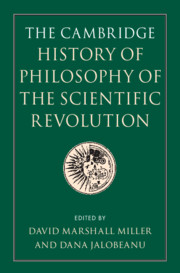Book contents
- The Cambridge History of Philosophy of the Scientific Revolution
- The Cambridge History of Philosophy of the Scientific Revolution
- Copyright page
- Contents
- Tables and Figures
- Contributors
- Preface
- Introduction The Disciplinary Revolutions of Early Modern Philosophy and Science
- Part I The Disciplines
- Part II Disciplinary Activities
- 8 The Art of Thinking
- 9 Astrology, Natural Magic, and the Scientific Revolution
- 10 Practitioners’ Knowledge
- 11 Medicine and the Science of the Living Body
- 12 Experimental Natural History
- 13 Celestial Physics
- 14 Applying Mathematics to Nature
- 15 Mathematical Innovation and Tradition: The Cartesian Common and the Leibnizian New Analyses
- 16 Mechanics in Newton’s Wake
- Part III Problems and Controversies
- Bibliography
- Index
16 - Mechanics in Newton’s Wake
from Part II - Disciplinary Activities
Published online by Cambridge University Press: 14 January 2022
- The Cambridge History of Philosophy of the Scientific Revolution
- The Cambridge History of Philosophy of the Scientific Revolution
- Copyright page
- Contents
- Tables and Figures
- Contributors
- Preface
- Introduction The Disciplinary Revolutions of Early Modern Philosophy and Science
- Part I The Disciplines
- Part II Disciplinary Activities
- 8 The Art of Thinking
- 9 Astrology, Natural Magic, and the Scientific Revolution
- 10 Practitioners’ Knowledge
- 11 Medicine and the Science of the Living Body
- 12 Experimental Natural History
- 13 Celestial Physics
- 14 Applying Mathematics to Nature
- 15 Mathematical Innovation and Tradition: The Cartesian Common and the Leibnizian New Analyses
- 16 Mechanics in Newton’s Wake
- Part III Problems and Controversies
- Bibliography
- Index
Summary
Newton’s remarkable achievements in planetary theory and dynamics were followed by a century of equally remarkable advances in the generalized science of forces acting on bodies in motion. Far from merelyformalizing the Newtonian framework, these advances aimed at solving deep problems left in Newton’s wake. First, Newtonian theory focused on centripetal forces, which are not characteristic of motion under arbitrary constraints or bodily deformation due to pressure and stress. Second, Newton’s attempts at fluid mechanics made clear that media could not be adequately analyzed using strategies developed for point-particles. Both considerations suggested that different forms of body required different analytical and conceptual tools. They required the formulation of generalized principles flexible enough to treat heterogeneous material configurations, but stringent enough to preserve the unity of mechanics as a study of matter and motion. Ultimately, Newton’s successors established a new discipline, analytical mechanics. Its primary object of investigation was the functional representation of the invariant relations behind dynamic phenomena, not the geometric representation of trajectories. The philosophical suppositions behind the new mechanics constituted a new mechanical philosophy, but one that hearkened back to, and completed the project of, the mechanical philosophy of the mid-seventeenth century.
Keywords
- Type
- Chapter
- Information
- The Cambridge History of Philosophy of the Scientific Revolution , pp. 293 - 312Publisher: Cambridge University PressPrint publication year: 2022
- 1
- Cited by

